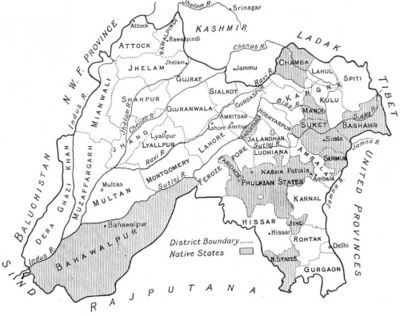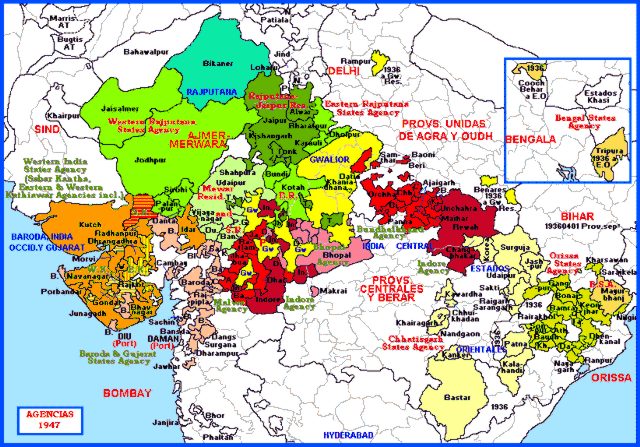In this, my seventh post on the distribution of tribes gazetted as agriculturalist, according to the 1901 Census of India will look at the Mahtam. In 1901, the total Mahtam population was 82,825, which was 0.3% of the population of undivided Punjab. Like many Punjab castes, the Mahtam were found as followers of all three religions of the Punjab, but with a clear Hindu majority of 48,586 (59%), followed by Sikhs at 19,183 (23%) and Muslims numbering 15,056 (18%). By 1931, the last census that counted caste, the Mahtam population had fallen to 65,210. Like many castes connected with agriculture, the Mahtam had been converting to Sikhism, in 1931 Sikhs now numbered 36,367 (56%), while Hindus had dropped to 15,482 (24%), while Muslims numbered 13,361 (20%), about the same percentage wise. The Sikh Mahtam now prefer the self-designation Rai Sikh.
The Mahtam were found mainly along the banks of the Sutlej and Ravi, in districts such as Firuzpur, Montgomery and princely state of Bahawalpur. In this region, they numbered 35,514, about 43% of the total population. They were found in three of the Divisions, which Punjab was divided in 1901, namely Lahore, Jalandhar and Multan, with no presence in the north-west (Rawalpindi Division) or south-east (Ambala Division). The largest number of Mahtam were in Firuzpur, home to 17% of their population, followed by Montgomery at 15%, Lahore at 12%, Bahawalpur State 12% and Hoshiarpur at 12%. About two-third of the Mahtam population was found in territory that went to Pakistan, as such they were one of the communities that suffered on account of the division of Punjab.

Map of Punjab 1911
Their population as percentage of the total district population was as such:
Lahore Division
Montgomery 3%
Lahore 1%
Amritsar 0.17%
The total Mahtam population in the division was 24,161, which was about 29% of the total population. In Montgomery, they made 3% of the total population, and this district was one of the main centres of the caste. In terms of religion, Hindus were 11,934 (49%), Sikhs were 7,048 (29%) and Muslims were 5,179 (22%) in the Division.
Jallandhar Division
Firuzpur 1.4%
Hoshiarpur 1%
Jalandhar 0.24%
The total Mahtam population in the Division, including Kapurthala State, was 29,418, about 36% of the total Mahtam population. In terms of religion, Hindus were 18,697 (64%), Sikhs were 7,731 (26%) and Muslims were 2,990 (10%).
Multan Division
Bahawlpur State 1.4%
Muzaffargarh 1.1%
Chenab Colony
Multan 0.7%
Dera Ghazi Khan 0.7%
The total Mahtam population in this Division, including the Bahawalpur State, was 29,206, which was 35% of the total Mahtam population. In terms of religion, Hindus were 18,006 (62%), Muslims were 7,021 (24%) and Sikhs were 4,179 (14%).
|
District |
Hindu |
Sikh |
Muslim |
Total |
|
Firuzpur |
10,067 | 2,326 | 1,335 | 13,728 |
| Montgomery | 6,793 | 4,628 | 757 | 12,178 |
| Lahore | 3,279 | 2,184 | 4,422 | 9,885 |
| Bahawalpur State | 6,943 | 1,478 | 1,419 | 9,840 |
| Hoshiarpur | 6,500 | 3,013 | 14 | 9,527 |
| Chenab Colony | 3,774 | 2,701 | 12 | 6,487 |
| Multan | 1,869 | 3,256 | 5,125 | |
| Muzaffargarh | 4,139 | 353 | 4,492 | |
| Kapurthala | 1,365 | 1,066 | 1,172 | 3,603 |
| Dera Ghazi Khan | 1,281 | 1,981 | 3,262 | |
| Jalandhar | 765 | 1,326 | 141 | 2,232 |
| Amritsar | 1,603 | 142 | 1,745 | |
| Sialkot | 259 | 94 | 353 | |
| Faridkot | 218 | 218 | ||
| Ludhiana | 110 | 110 | ||
|
Other Districts |
|
|
|
40 |
|
Total |
48,586 |
19,183 |
15,056 |
82,825
|


